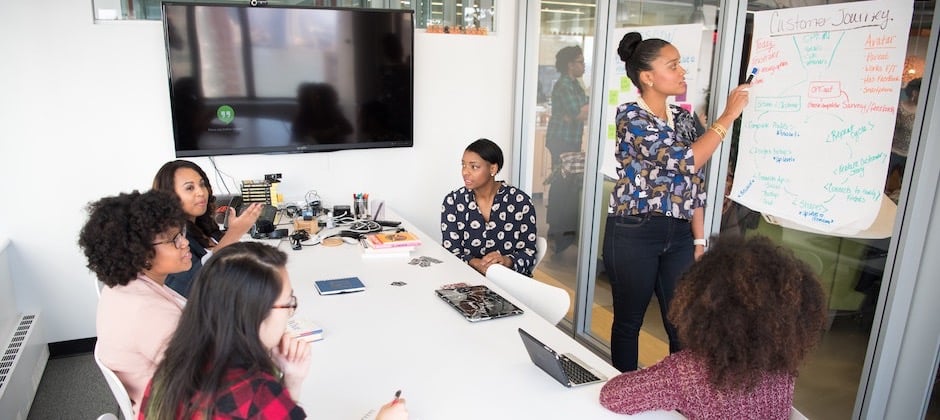Are you a corporate training provider looking to strengthen your marketing campaigns? Download our free findcourses.com buyer persona template to help you create targeted personas for corporate training buyers and sharpen your strategy.
What is a Buyer Persona?
A buyer persona is a fictionalized character who embodies certain characteristics of an organization’s ideal customer. A corporate training buyer persona has certain learning and development goals and challenges.
You can create multiple buyer personas if your course offerings attract different personas or if you simply want to build a fuller picture of your target customers.
Benefits of Creating Buyer Personas When Marketing Education
Taking the time to create corporate training buyer personas can help you:
-
Develop a deeper understanding of your target customers. Detailed descriptions of the education buyers’ background, goals and pain points will help the marketing and content team get to know the customers’ perspectives more intimately.
-
Tailor content for an education buyer’s long journey. With your buyer personas in mind, you can create engaging content that is tailored to meet corporate training buyers’ needs. Tailoring your content is particularly important because corporate training buyers tend to have a longer buyer’s journey. Buying education is a big decision with substantial investments of time and money. It is also a decision that can potentially impact the learner’s life significantly.
-
Attain a higher conversion rate. By developing a deeper understanding of your ideal customers and creating tailored content that accompanies them on their long buyer’s journey, you will improve your chances of enjoying higher conversion rates.
What Should You Include in a Buyer Persona Template for Corporate Training?
We have created a buyer persona template aimed specifically at the corporate training market. The template can help guide you through the process of creating buyer personas of your ideal customers.
Each of these categories provides valuable information on your target customers. These pieces of information, when put together, will help you gain a deeper understanding of your ideal customers, as well as insights into how you can tailor your marketing approach to your various buyer personas.
1. Demographics
You can begin to build up a picture of your target customer with some demographic information. In addition, information such as location and income level will enable you to ensure that your available course offerings are pitched at the right audiences.
-
Age
-
Gender
-
Location
-
Income level
2. Educational Background and Work History
Include the key educational information that informs this person’s work history as well as their current and future learning and development goals. Educational background can include:
-
Formal education-to-date
-
Internal training undertaken at the workplace
Include this person’s current role and responsibilities, as well as the length of time they have been in their current role. Add any previous roles, especially those that may be relevant to this person’s learning and development goals.
3. Sources of Influence
Identify this person’s sources of influence. Which channels or sources do they like and trust? How do these sources influence their educational decisions? These sources could include:
-
Family and friends. For example, friends undertaking a similar program, desire to stay in the same city or relocate due to family reasons.
-
Social media e.g. LinkedIn
-
Niche channels e.g. blogs for particular hobbies, podcasts
4. Goals
The education buyer’s professional and personal goals that spur them to purchase education for themselves or others. Perhaps their goal is to get a promotion or enter a field with higher job security. Or perhaps their aim is for their team or company to be the best in the field.
5. Challenges
Imagine what makes it difficult for this person to reach their goals. Some examples include not having the time to attend classes, unable to convince their manager to fund education and not having the knowledge to understand which courses and qualifications can propel them into a particular career.
6. What can we do?
Decide what you can offer to help this person meet their goals and overcome their challenges. Your solutions could include guides, articles, tools, discounts, timely emails and delivery options.
7. Why not use us?
Identify potential barriers that are preventing your organization from reaching this person. Examples of barriers include lack of awareness of your course offerings and price sensitivity. Determine how these barriers can be overcome, for instance through clearer messaging.
8. Messaging
Establish the goal of your messaging. Is it to highlight how your offerings can meet this person’s goals? Or is it to overcome certain potential barriers that are currently preventing your organization from reaching this person? Then, in your marketing communications, determine what tone is important when communicating with this person. For instance, you may wish to emphasize trustworthiness, expertise or approachability.
9. Elevator Pitch
Create a short, persuasive message to spark interest in your organization’s educational and training offerings. Tailor this message specifically to this person who has these characteristics, goals and challenges. The message should be about a paragraph in length and should be appropriate for a brief face-to-face meeting.
How to Get the Information to Create a Buyer Persona?
There are several ways you can find the information to populate the buyer persona templates and bring your corporate training buyer personas to life.
1. Database of current and past customers
Interrogate your existing customer relationship management database to search for any trends and insights into your customer base. You can see how your existing buyers found your courses. You can also comb through your customers’ information to learn the appeal of your course offerings by industry or job roles.
2. Your teachers and instructors
Quiz your course instructors and teachers. They would have probably spent the most time with your current and past students. Through their interactions with the students, your teachers and instructors would have picked up insights into their students’ learning goals and motivations. They would also understand some of the learners’ challenges - whether these challenges are related to the courses or their careers.
3. Sales and customer support teams
Ask your sales team for insights into prospective education buyers. Sales representatives would have direct contact with prospective buyers and they would be able to share information about customer preferences and pain points.
Customer support teams would also be able to provide invaluable information about the buyer’s after-sales journey.
Sales and customer support teams might have hard data in the form of notes taken during meetings, calls or online chat support.
4. Professional bodies and trade associations
Identify the professional bodies and trade associations that are relevant for your learners. Stay up-to-date on industry news for instance via newsletters and magazines from these professional and trade organizations. You can also join a LinkedIn group and network with members from these organizations. Engaging with the relevant professional and trade associations will enable you to learn more about the members’ learning goals and motivations.
5. Review analytics
Examine your web and email analytics so you can track the corporate training buyer’s journey. You can see some demographics information, where website visitors come from, and which content they are most engaged with. You can also analyse the calls to action and email subject lines that seem to work well with the education buyers. If you have specific sections of your website that are targeted to certain personas, you can create a segment in Google Analytics to observe how their demographics and website behaviour differ from others.
6. Conduct market research
This would take some planning but you would be able to get the most relevant information when you conduct a well-designed and effectively executed market research exercise. These market research exercises can take the form of online surveys, in-person focus groups or telephone interviews.
Do you want to start creating targeted buyer personas for your corporate training buyers? Download our corporate training buyer persona template today.







-2.png)
